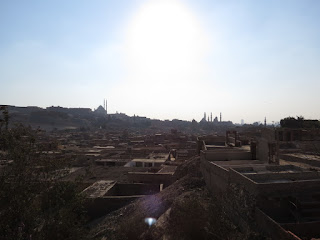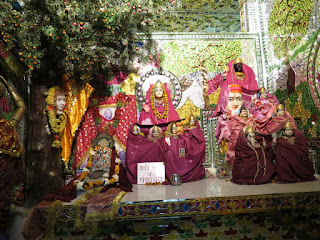After getting duped by an unscrupulous cabbie and then helped by some nice Egyptians who work at McDonalds, I get a short night's sleep. In the morning, I got up and met the people in the hostel and one of the residents. Her name was Chavonne, and she was from Britain. We got to talking and then she told me she was going to go and visit the Citadel. This was apparently an old part of Cairo and a fortress of some sort. I had no other idea of what I was going to do, so when she invited me along, I agreed.
While I don't normally do a lot of taxi riding (as I generally find them to be nasty business and always out to get the customer), she wanted to take a taxi and said that they were pretty good here, the white taxis use meters and it was pretty cheap. The taxi we got into had a driver that initially had no idea where we wanted to go. I guess many taxi drivers here didn't grow up in Cairo, so they don't actually know the city very well. But this is a major tourist attraction in the city, and you would think...
But after asking lots of people and going way out of the way, we did eventually get to the Citadel. And then I discovered something rather refreshing about Egypt. It appears that everyone, Egyptian and foreign visitor alike, are treated the same. There didn't seem to be a price difference in the entrance fees. That was nice.
 Inside the Citadel, which sits on a hill overlooking the city, there are a number of museums and a well-known mosque, the Muhammed Ali Mosque (but I don't think it is the Muhammed Ali that we would think of). Chavonne particularly wanted to see one of the museums, and we followed the signs up that seemed to lead to it. They also point to the mosque, and that is where we first ended up. She didn't feel much like going in, so I took off my sandals, to the consternation of the guy who was trying to sell me little plastic booties to put over them, and went in. At the entrance, my feet became a hilarious point of interest for the door-minders. I have been wearing sandals for months now, in the bright sun. The patterns of tanned and white skin is rather interesting and they thought it was quite funny.
Inside the Citadel, which sits on a hill overlooking the city, there are a number of museums and a well-known mosque, the Muhammed Ali Mosque (but I don't think it is the Muhammed Ali that we would think of). Chavonne particularly wanted to see one of the museums, and we followed the signs up that seemed to lead to it. They also point to the mosque, and that is where we first ended up. She didn't feel much like going in, so I took off my sandals, to the consternation of the guy who was trying to sell me little plastic booties to put over them, and went in. At the entrance, my feet became a hilarious point of interest for the door-minders. I have been wearing sandals for months now, in the bright sun. The patterns of tanned and white skin is rather interesting and they thought it was quite funny. Inside the mosque, it was quite nice. There were elaborate decorations and carpets. It was a very beautiful mosque and I was sorry that Chavonne hadn't wanted to come in. She would have liked it.
Inside the mosque, it was quite nice. There were elaborate decorations and carpets. It was a very beautiful mosque and I was sorry that Chavonne hadn't wanted to come in. She would have liked it. Outside, there was a viewing area that gave a great view out over the city of Cairo. It is quite amazing looking out over all the mosques with their minarets.
Outside, there was a viewing area that gave a great view out over the city of Cairo. It is quite amazing looking out over all the mosques with their minarets. We looked in vain for the museum Chavonne wanted to find. Despite a bunch of signs with arrows pointing in its direction, we never found it.
Nor did we find many of the other museums. The carriage museum wasn't taking visitors. There was only one of the museums on the site that seemed to be open and it was the military museum. It may have been interesting, but neither of us was particularly interested in it, so we tried to go out a different gate than the one we came in. We wanted to head down the hill to another mosque, the Blue Mosque. But that proved a futile effort as well, as we were told we couldn't go the way we thought we needed to go. That way was closed, even though we saw people coming up from that direction. Oh well.
We headed out the opposite gate to where we wanted to be. That was when I discovered that Chavonne was the same sort of person as me. Many people would just hire a taxi at that point and go to the next spot. But I figured we ought to be able to get there by walking around the Citadel's hill at the base and going from there. Chavonne was game. Cool!!
 So we did. We did find the opposite side and then we had some trouble following directions to the Blue Mosque that we were given by some friendly neighbourhood Egyptians. We ended up in the City of the Dead, the cemetery at the base of the Citadel's hill. People also lived there. And while we were walking along, an old man came the other direction. He seemed so happy to see us. He smiled and shook our hands and said something that I couldn't understand. But he was nice.
So we did. We did find the opposite side and then we had some trouble following directions to the Blue Mosque that we were given by some friendly neighbourhood Egyptians. We ended up in the City of the Dead, the cemetery at the base of the Citadel's hill. People also lived there. And while we were walking along, an old man came the other direction. He seemed so happy to see us. He smiled and shook our hands and said something that I couldn't understand. But he was nice. As we realized we were in the City of the Dead, we also came to the conclusion we had ended up on the wrong side of a park we had seen from the Citadel. We needed to be on the north side of the park, but we were on the south side. We decided to find the entrance of the park and go in. We both wanted a rest. It took some doing, including walking for a short ways along the expressway without a pavement, but we did make it in the end.
It was a nice park. It seemed to be relatively new and was a green space amongst the dusty, drab colours of the rest of the city. I quite liked it. And I had a great view of a beautiful sunset over the city. For a first day in the city after a rather ignominious arrival, it wasn't bad at all. Cairo is a beautiful city.


























































